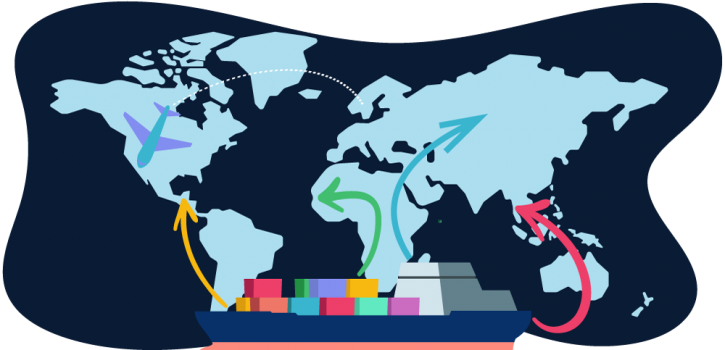If you’re an international company and more specifically a cross-border e-commerce business, you obviously need to ship across international borders, and might be wondering why the price seems to change on a dime. As you might imagine, there are many variables involved in getting goods and shipments from one country to the next. From economic conditions to the price of fuel and dicey international disputes, it might take a while for your packages to arrive at their destination. You can better prepare for changing shipping costs by learning about the factors that influence them. Learn more about why international shipping rates are always changing.
Cost of Fuel
Regardless of how you’re shipping packages, you’re going to need some type of fuel. Fuel costs always seem to be in flux, which means the prices to ship your goods will change as well. When fuel prices go up, shipping companies will need to pass along these extra costs to their customers. All sorts of events can set off a change in the price of fuel. If an oil producer is sitting on a large supply of oil, it will flood the market and drive down the price of fuel. Nasty international disputes can also cut off a country’s oil supply, driving up the price of fuel dramatically.
Due to the unpredictability of fuel prices, many shipping companies are investing in energy-efficient technology as a way of curbing their dependency on fossil fuels. This can help lessen the negative effects of rising fuel prices on the cost of international shipping, but shipping companies will still have to raise their prices on their customers.
Trade Tariffs and Customs
Cross-border e-commerce equals shipping to another country, which also means the potential for trade tariffs, or taxes on goods imported from another country. When a consumer or company orders goods from another country with trade tariffs in place, they will need to pay a tax on this purchase, driving up the cost of international shipping. A country may decide to impose trade tariffs as a way of giving a leg up to domestic production and manufacturing, or they may be used as a way of punishing a country that’s engaged in unlawful behavior. When a country imposes trade tariffs on another country, the country on the receiving end is likely to implement trade tariffs of its own, limiting trade between the two countries.
Trade tariffs are a direct result of international relations. Countries may dispute human rights abuses, the proliferation of nuclear weapons or issues of sovereignty. Companies may be forced to find suppliers in other countries as a way of avoiding these costly tariffs. Some tariffs may be permanent, while others may go into effect temporarily until the two countries can reach an agreement.
Security
Some countries may also impose stiff security measures at shipping ports. This is usually common in countries with authoritarian rule or those that are undergoing a state of emergency. These countries may be skeptical of all incoming packages and may put them through rigorous screening processes before they’re allowed to enter the country. These added security measures may delay a shipment or impact overall shipping costs if the port issues a security surcharge. Shipping companies should have a keen sense of which ports levy these kinds of charges, so they can charge their customers an additional fee.
Port Congestion
The busiest ports in the world can create bottlenecks in the supply chain, which can increase fuel costs and delay package deliveries. These ports tend to be in Asia, including Singapore and Hong Kong, as China and other Asian countries ramp up domestic production and exports. If you’re trying to ship to one of the busiest ports in the world, there’s always a chance that your shipping could cost more and take longer than expected. As these countries and ports get used to the increased flow of traffic, hopefully some of these disruptions and delays can be avoided in the future. But until then, shipping companies know how difficult getting in and out of these ports can be and will charge their customers accordingly.
Size and Weight
Just like domestic shipping, the size and weight of your shipping containers will also affect the cost of international shipping. But unlike domestic shipping, your transportation methods will be limited if you’re trying to get your packages across the ocean. This leaves you with air and ocean freight shipping as your only two options. If you’re trying to get your package overseas as fast as possible, you’ll want to go with air freight, but a few extra pounds in cargo can cost you a fortune when using air freight shipping.
Transportation Method
The transportation method you choose will also have an impact on your international shipping rates. If you’re shipping overseas, you’ll have a choice between air and ocean freight shipping. The cost of international shipping can vary greatly between the two. Air freight shipping will be more expensive than ocean freight shipping, sometimes costing five times as much as ocean shipping.
There are many advantages that come with air freight shipping to make it worth the extra money. Air freight shipping is faster and more reliable than ocean freight shipping. It may take several hours for your package to arrive in another country, while ocean freight shipping can take up to a week or more in some cases. Sailing on the open seas can also be unpredictable as vessels are bound to encounter all kinds of weather delays. Air freight shipping also comes with strict size and weight limitations, so if you have heavy cargo, you might be forced to ship your package using ocean freight.
Final Thoughts
You’re bound to encounter all kinds of variables when shipping packages to another country. Shipping to another country that’s on the same continent gives you more transportation options, including truck and rail freight shipping, which can help you avoid some of these cost variables. International shipping is certainly a big part of your cross-border e-commerce business, so remember to keep your eyes on the factors mentioned above, including the changing price of fuel, international relations as they relate to your trading partners, security changes and port congestion. The more you know about international shipping, the more informed your decisions will be.







